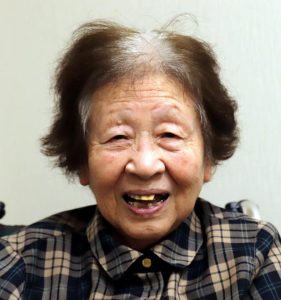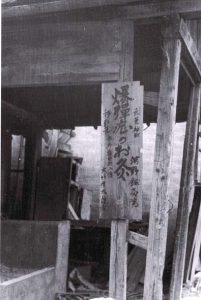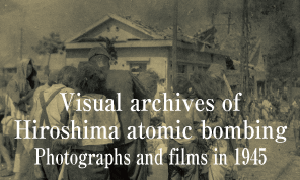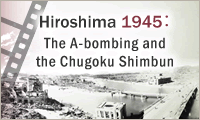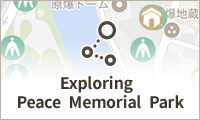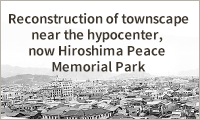Documenting Hiroshima of 1945: Mid-October, reliance on folk remedy spreads among survivors
Oct. 14, 2024
by Minami Yamashita, Staff Writer
In mid-October, 1945, a signboard reading “Moxibustion for A-bomb disease” for an acupuncture and moxibustion clinic was hanging at the base of Kojin Bridge (in Hiroshima City’s present-day Minami Ward), located near Hiroshima Station. Expectations were that moxibustion therapy would be effective against “A-bomb disease,” which many citizens were struggling with at the time.
There was a reason for this. One of the acute symptoms of radiation exposure was a decrease in white blood cell count. People started to believe that moxibustion therapy would have an effect by increasing white blood cell count and strengthening immunity.
The headline of an article carried in the Chugoku Shimbun on September 8, 1945, read, “Try Moxibustion Immediately, Miraculous Effect on Atomic Bomb Disease.” The article reported that many patients, including those with severe symptoms such as fever, hair loss, and spotting on their bodies, began to improve after receiving the therapy from a practitioner.
Miyako Imae, 92, a resident of Hatsukaichi City who at the time was a second-year student at Hiroshima Jogakuin Girls’ High School (present-day Hiroshima Jogakuin Junior and Senior High School, located in the city’s present-day Naka Ward), was one of those who relied on moxibustion. She experienced the atomic bombing while engaged in building-demolition work in the Zakoba district (in present-day Naka Ward), around one kilometer from the hypocenter. Approximately one week later, suffering from symptoms of hair loss and bleeding gums, she became bedridden.
Her parents, who had been living in the area of Nishishin-machi (in Hiroshima’s present-day Naka Ward), were killed in the atomic bombing, leaving Ms. Imae to stay at her father’s family home in the town of Hatasukaichi-cho (present-day Hatsukaichi City). Based on the information published in the newspaper, she was placed on a stretcher every day, “And I was taken to an acupuncture and moxibustion clinic near Hatsukaichi Station, where I received moxibustion. The therapy was hot.” Her consciousness, which had been hazy to that point, gradually returned, but her appetite did not, leaving her unable to stand. She remained in bed for half a year.
Nekohachi Edoya III (real name, Rokuro Okada) was a performer who experienced the atomic bombing in the area of Ujina-machi (in Hiroshima’s present-day Minami Ward) and died in 2001 at the age of 80. In his personal account titled Kinokogumo kara Haidashita Neko (in English, ‘The cat who crawled out from under the mushroom cloud’), published in 1995, he wrote that he had also resorted to moxibustion therapy around the same time. He engaged in rescue efforts and the disposal of corpses immediately after the bombing for the Imperial Japanese Army’s Shipping Command. After being demobilized from the military and returning to Tokyo in September, his white blood cell count dropped and his hair fell out.
According to the personal account, his acquaintance had recommended moxibustion to him because, “It’s the best treatment to increase your white blood cell numbers.” Moxibustion therapy caused Mr. Edoya’s heart to race, given his weakened physical state. Unable to tolerate the heat of the moxibustion, he reported that he had stopped the therapy after 10 days.
(Originally published on October 14, 2024)
In mid-October, 1945, a signboard reading “Moxibustion for A-bomb disease” for an acupuncture and moxibustion clinic was hanging at the base of Kojin Bridge (in Hiroshima City’s present-day Minami Ward), located near Hiroshima Station. Expectations were that moxibustion therapy would be effective against “A-bomb disease,” which many citizens were struggling with at the time.
There was a reason for this. One of the acute symptoms of radiation exposure was a decrease in white blood cell count. People started to believe that moxibustion therapy would have an effect by increasing white blood cell count and strengthening immunity.
The headline of an article carried in the Chugoku Shimbun on September 8, 1945, read, “Try Moxibustion Immediately, Miraculous Effect on Atomic Bomb Disease.” The article reported that many patients, including those with severe symptoms such as fever, hair loss, and spotting on their bodies, began to improve after receiving the therapy from a practitioner.
Miyako Imae, 92, a resident of Hatsukaichi City who at the time was a second-year student at Hiroshima Jogakuin Girls’ High School (present-day Hiroshima Jogakuin Junior and Senior High School, located in the city’s present-day Naka Ward), was one of those who relied on moxibustion. She experienced the atomic bombing while engaged in building-demolition work in the Zakoba district (in present-day Naka Ward), around one kilometer from the hypocenter. Approximately one week later, suffering from symptoms of hair loss and bleeding gums, she became bedridden.
Her parents, who had been living in the area of Nishishin-machi (in Hiroshima’s present-day Naka Ward), were killed in the atomic bombing, leaving Ms. Imae to stay at her father’s family home in the town of Hatasukaichi-cho (present-day Hatsukaichi City). Based on the information published in the newspaper, she was placed on a stretcher every day, “And I was taken to an acupuncture and moxibustion clinic near Hatsukaichi Station, where I received moxibustion. The therapy was hot.” Her consciousness, which had been hazy to that point, gradually returned, but her appetite did not, leaving her unable to stand. She remained in bed for half a year.
Nekohachi Edoya III (real name, Rokuro Okada) was a performer who experienced the atomic bombing in the area of Ujina-machi (in Hiroshima’s present-day Minami Ward) and died in 2001 at the age of 80. In his personal account titled Kinokogumo kara Haidashita Neko (in English, ‘The cat who crawled out from under the mushroom cloud’), published in 1995, he wrote that he had also resorted to moxibustion therapy around the same time. He engaged in rescue efforts and the disposal of corpses immediately after the bombing for the Imperial Japanese Army’s Shipping Command. After being demobilized from the military and returning to Tokyo in September, his white blood cell count dropped and his hair fell out.
According to the personal account, his acquaintance had recommended moxibustion to him because, “It’s the best treatment to increase your white blood cell numbers.” Moxibustion therapy caused Mr. Edoya’s heart to race, given his weakened physical state. Unable to tolerate the heat of the moxibustion, he reported that he had stopped the therapy after 10 days.
(Originally published on October 14, 2024)

